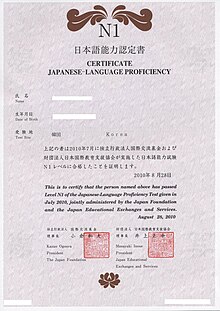Japanese-Language Proficiency Test
The Japanese- Language Proficiency Test ( JLPT , Japanese 日本語 能力 試 験 nihongo nōryoku shiken ) is a standardized test to test the knowledge of the Japanese language for non-native speakers, mainly in the area of reading and listening comprehension. It was developed and implemented by the Japan Foundation in 1984 to provide participants with an assessment basis for their listening and reading comprehension of the Japanese language. Until 2003 also a requirement for foreigners to enroll at Japanese universities, the Examination for Japanese University Admission for International Students (EJU, examination for the admission of foreign students to Japanese universities ) must now be taken.
Exam location
The test is held annually on the first Sunday in December both in and outside of Japan. In some countries, the test is also held on the first Sunday in July. In German-speaking countries, it can be taken at the Japanese Cultural Institute in Cologne together with the Düsseldorf Adult Education Center , the Stuttgart Adult Education Center and the Center for Language and Culture of Japan at the Humboldt University in Berlin ; since 2005 also at the adult education center in Bern and since 2010 at the University of Hamburg . It is recognized by around 12,000 educational institutions worldwide. In 2006 the JLPT took place in 47 countries. Of the 437,360 candidates (533,189 registrations), 196,749, i.e. 45.0 percent, passed.
Exam content
The test has been carried out in five different levels of difficulty (also known as level, Japanese 級 kyū ) since 2010 , with level N5 (Japanese 5 級 gokyū ) being the easiest and level N1 (Japanese 1 級 ikkyū ) the most difficult. The N stands for “New” and “Nihongo”. This new division served to bridge the large gap between the previous levels 2 and 3. Levels N1 and N2 are divided into 2 parts, vocabulary / grammar knowledge / reading comprehension and listening comprehension. Levels N3 to N5 are further divided into 3 parts, vocabulary, grammar knowledge / reading comprehension and listening comprehension . It is neither spoken nor written. Cultural and historical aspects are not taken into account in this test. The JLPT assessment does not provide for grades.
| Level | Parts | time | Points | Content | Participants - Success Rate (2011 July) | |||||||||
|---|---|---|---|---|---|---|---|---|---|---|---|---|---|---|
| N1 | Speech comprehension / reading comprehension Total listening comprehension |
110 min 60 min 170 min |
120 60 180 |
2,000 Kanji 10,000 vocabulary |
|
|||||||||
| N2 | Speech comprehension / reading comprehension Total listening comprehension |
105 min 50 min 155 min |
120 60 180 |
1,000 Kanji 6,000 vocabulary |
|
|||||||||
| N3 | Vocabulary grammar / reading comprehension listening comprehension total |
30 min 70 min 40 min 140 min |
60 60 60 180 |
650 Kanji 3,000 words |
|
|||||||||
| N4 | Vocabulary grammar / reading comprehension listening comprehension total |
30 min 60 min 35 min 125 min |
60 60 60 180 |
320 Kanji 1,500 words |
|
|||||||||
| N5 | Vocabulary grammar / reading comprehension listening comprehension total |
25 min 50 min 30 min 105 min |
60 60 60 180 |
120 Kanji 800 vocabulary |
|
If the tests are passed, the participants receive an official certificate from The Japan Foundation , which is awarded centrally. It can take until March of the following year for all participants to receive their certificates.
Necessary study hours
Necessary learning hours to pass:
| Level | Students with knowledge of Kanji
(e.g. Chinese or Korean) |
Other students
(without knowledge of Kanji) |
|---|---|---|
| N1 | 1700-2600 hours | 3000-4800 hours |
| N2 | 1150-1800 hours | 1600-2800 hours |
| N3 | 700–1100 hours | 950–1700 hours |
| N4 | 400-700 hours | 575-1000 hours |
| N5 | 250-450 hours | 325-600 hours |
fees
For all levels there are currently examination fees of 60 euros each.
Individual evidence
- ↑ Figures from the Japan Foundation homepage .
- ↑ http://www.jlpt.jp/e/ Status 2010.
- ↑ As of 2005.
- ^ Past Test Data - Data of the test in 2011 (July). The Japan Foundation, accessed January 22, 2012 .
- ↑ Necessary learning hours to pass (comparative data from 2010 to 2015) . The Japan Language Education Center. Archived from the original on November 17, 2015. Retrieved November 16, 2015.
- ↑ http://iaaw.hu-berlin.de/japan/jlpt/anmeldung
Web links
- Nihongo nōryoku shiken - Official JLPT homepage (Japanese and English)
- Japan Foundation: List of Organizations Hosting the Test (outside of Japan )
- JEES Japan Educational Exchanges and Services: Information about the Japanese Language Proficiency Test (English)
- JLPT online vocabulary trainer for levels 4, 3 and 2 (German)
- Kanji Trainer Free online Kanji tutorial with memorable phrases for each of the 2136 jōyō characters
